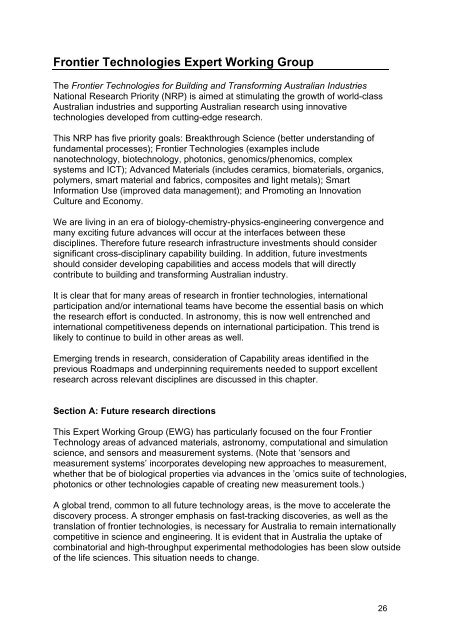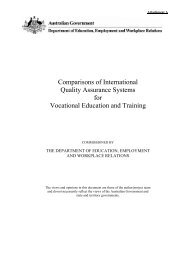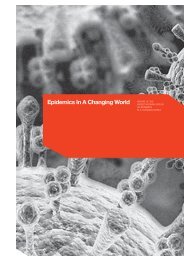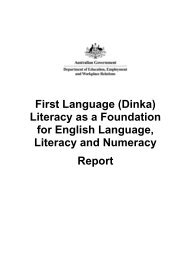2011 Strategic Roadmap for Australian Research Infrastructure
2011 Strategic Roadmap for Australian Research Infrastructure
2011 Strategic Roadmap for Australian Research Infrastructure
You also want an ePaper? Increase the reach of your titles
YUMPU automatically turns print PDFs into web optimized ePapers that Google loves.
Frontier Technologies Expert Working Group<br />
The Frontier Technologies <strong>for</strong> Building and Trans<strong>for</strong>ming <strong>Australian</strong> Industries<br />
National <strong>Research</strong> Priority (NRP) is aimed at stimulating the growth of world-class<br />
<strong>Australian</strong> industries and supporting <strong>Australian</strong> research using innovative<br />
technologies developed from cutting-edge research.<br />
This NRP has five priority goals: Breakthrough Science (better understanding of<br />
fundamental processes); Frontier Technologies (examples include<br />
nanotechnology, biotechnology, photonics, genomics/phenomics, complex<br />
systems and ICT); Advanced Materials (includes ceramics, biomaterials, organics,<br />
polymers, smart material and fabrics, composites and light metals); Smart<br />
In<strong>for</strong>mation Use (improved data management); and Promoting an Innovation<br />
Culture and Economy.<br />
We are living in an era of biology-chemistry-physics-engineering convergence and<br />
many exciting future advances will occur at the interfaces between these<br />
disciplines. There<strong>for</strong>e future research infrastructure investments should consider<br />
significant cross-disciplinary capability building. In addition, future investments<br />
should consider developing capabilities and access models that will directly<br />
contribute to building and trans<strong>for</strong>ming <strong>Australian</strong> industry.<br />
It is clear that <strong>for</strong> many areas of research in frontier technologies, international<br />
participation and/or international teams have become the essential basis on which<br />
the research ef<strong>for</strong>t is conducted. In astronomy, this is now well entrenched and<br />
international competitiveness depends on international participation. This trend is<br />
likely to continue to build in other areas as well.<br />
Emerging trends in research, consideration of Capability areas identified in the<br />
previous <strong>Roadmap</strong>s and underpinning requirements needed to support excellent<br />
research across relevant disciplines are discussed in this chapter.<br />
Section A: Future research directions<br />
This Expert Working Group (EWG) has particularly focused on the four Frontier<br />
Technology areas of advanced materials, astronomy, computational and simulation<br />
science, and sensors and measurement systems. (Note that ‘sensors and<br />
measurement systems’ incorporates developing new approaches to measurement,<br />
whether that be of biological properties via advances in the ’omics suite of technologies,<br />
photonics or other technologies capable of creating new measurement tools.)<br />
A global trend, common to all future technology areas, is the move to accelerate the<br />
discovery process. A stronger emphasis on fast-tracking discoveries, as well as the<br />
translation of frontier technologies, is necessary <strong>for</strong> Australia to remain internationally<br />
competitive in science and engineering. It is evident that in Australia the uptake of<br />
combinatorial and high-throughput experimental methodologies has been slow outside<br />
of the life sciences. This situation needs to change.<br />
26
















